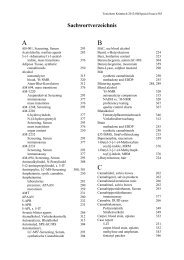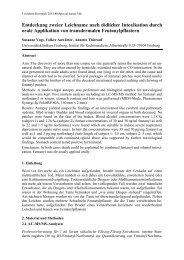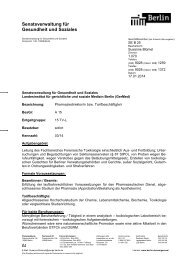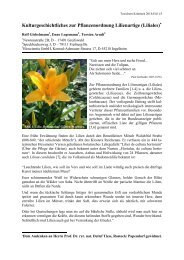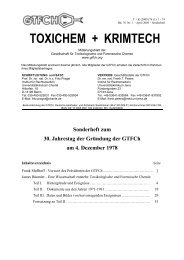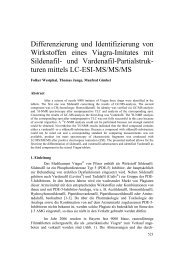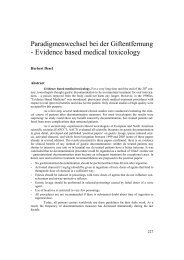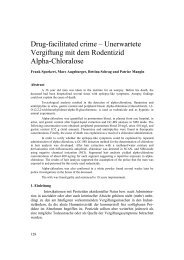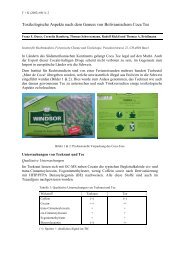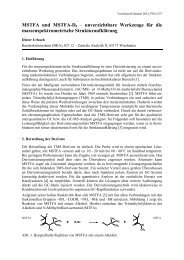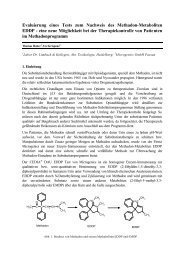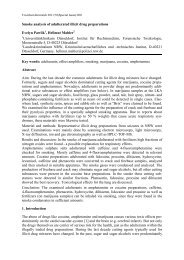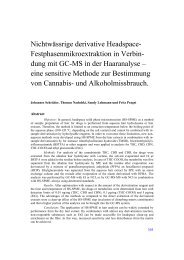Poisoning with unknown substance, “Munchhausen by ... - GTFCh
Poisoning with unknown substance, “Munchhausen by ... - GTFCh
Poisoning with unknown substance, “Munchhausen by ... - GTFCh
You also want an ePaper? Increase the reach of your titles
YUMPU automatically turns print PDFs into web optimized ePapers that Google loves.
Toxichem Krimtech 2013;80(1):39<br />
was an otherwise healthy child and did not have any reported infections, coughs or diarrhea<br />
during the previous weeks. Accidental intoxication from cleaning agents, medication or other<br />
household toxins had not been observed <strong>by</strong> the mother. According to the mother the boy had<br />
been at his father’s the previous day; the father and mother are separated, and the father lives<br />
<strong>with</strong> his parents. As a result of a car accident, the father suffers from paraplegia and has been<br />
treated <strong>with</strong> various drugs. He lives alone and manages his live <strong>by</strong> himself. The parents of the<br />
mother’s new friend (now her husband) and the father see the child regularly at weekends.<br />
The most important medication was:<br />
Baclofen (Lioresal): muscle relaxant, spasms of the muscular system from spinal<br />
marrow disease, spinal cord injury or MS, inflammation and other medical conditions<br />
Gabapentin (Neurontin): anticonvulsant, indication as concomitant treatment of partial<br />
cramps (adults), pain relief of post-herpetic neuralgia<br />
Tolterodine (Detrusitol): specific muscarinic receptor antagonist, anticholinergic drug:<br />
is mainly used to treat urinary incontinence<br />
3. Development, examinations after hospital admittance<br />
Upon admittance, the boy was in good general health; a blood sample was taken to be certain.<br />
The medically relevant laboratory analyses were unobtrusive except for a slightly raised<br />
thrombin time (24 sec reference values 13-22) and a weak acidosis two hours after admittance.<br />
Fluid was administered (NaCl 0.9%) as a precaution. The laboratory parameters tested referred<br />
to the kidneys, liver, heart, respiratory function, acid-bases and electrolyte balance,<br />
clotting and glucose. Further examinations such as CT etc. were normal.<br />
During his stay in the emergency department, the boy became noticeably apathetic and fell<br />
asleep. The vital parameters are monitored during this time. Two hours after admittance the<br />
boy vomited several times, <strong>with</strong>out blood, while asleep. Within a short space of time he became<br />
comatose <strong>with</strong> a GCS of 4-6. He was transferred to the intensive care unit as his condition<br />
became critical (EEG showed highly pathological findings). During this period, a urine<br />
sample was taken for toxicological testing. It took 24 hours before the boy could be extubated<br />
and was able to breathe spontaneously again. Days later he was transferred to the general<br />
ward. He was released after 14 days.<br />
4. Toxicological Analysis<br />
Upon admission, the screening via immunoassays for common drugs in urine was negative.<br />
Just three days after admission and as a result of several interviews <strong>with</strong> the mother (during<br />
which it should be pointed out that she frequently referred to her ex-husband’s medication and<br />
there<strong>by</strong> causing direct suspicion in his way), the possibility of a medication intoxication could<br />
not be ruled out leading to the order the boy’s blood the first day of admission to be re-tested<br />
(this was, however, no longer available in the hospital). Medications that could have been the<br />
potential culprit were Baclofen, Gabapentin, Amitriptyline, Tolterodine.<br />
Amitriptyline was ruled out from the start since the TCA analysis was negative. Regarding<br />
the other medications, a rapid validation for new parameters had to be carried out prior to<br />
analysis as a supplement to the existing “general target screening” <strong>with</strong> LCMSMS via reference<br />
material from medicine (hospital pharmacy).<br />
Urine from the day of admittance was still available which was forwarded to us after consultation<br />
<strong>with</strong> the patient’s general practitioner.



